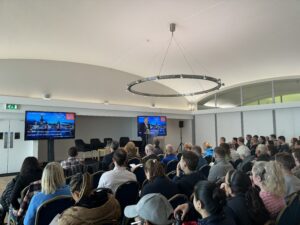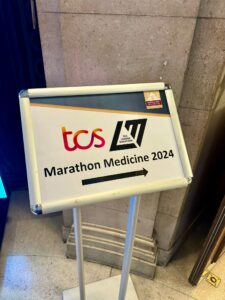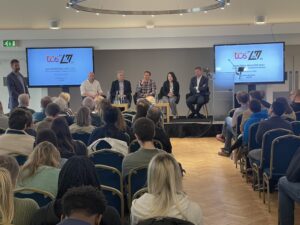Authors: Professor Courtney Kipps, Professor Charlie Pedlar & Dr Amy Boalch
This year was a special occasion for the Marathon Medicine Conference, as it marked its 40th year. The venue conference saw a change, with the conference held at Central Hall Westminster, and the conference committee welcomed a new member – Dr Amy Boalch. What didn’t change, however, is the high quality of expert speakers who delivered some exciting talks ahead of the London Marathon. We’ve summarised these talks below, but we hope you can join us in person next year!
Does running a marathon alter foot shape? And does it matter?
Speaker: Dr Mako Fukano; College of Engineering, Shibaura Institute of Technology, Japan
Mako opened her talk by reflecting on the increase in physical activity levels we saw during the pandemic, with individuals seeking both mental and physical health benefits. However, she emphasised that injury is the main reason for cessation of physical activity, so an understanding of potential injury risks is vital in keeping the population moving. Her research has focussed specifically on foot shape changes during marathon running. Given that a runner takes an average 19,179 steps during a marathon, it is unsurprising that foot shape does indeed alter. Mako’s research group collected 3D foot morphology data on runners before and after the Mount Fuji marathon using an optical foot scanner. They found that navicular bone height decreases across the marathon distance, and this decrease is greater for runners with higher pre-race navicular heights and faster marathon times. Interestingly, the decrease in navicular bone height in marathon runners persists for more than a week after their event, with an associated increased risk of both cutaneous and musculoskeletal injuries during this time.
Further reading: Fukano M, Nakagawa K, Inami T, Higashihara A, Iizuka S, Narita T, Maemichi T, Yoshimura A, Yamaguchi S, Iso S. Increase in foot arch asymmetry after full marathon completion. Journal of sports sciences. 2021 Nov 2;39(21):2468-74.
Running a marathon will not wear out your joints but will improve them
Speaker: Prof Alister Hart MA MD FRCS(Orth); Chair of Orthopaedics, UCL, London and Consultant Orthopaedic Hip Surgeon, Royal National Orthopaedic Hospital (RNOH) NHS Trust and Cleveland Clinic London, UK
The work Alister shared with our audience was inspired by his participation in the New York Marathon, which changed his direction of research to become more exercise focussed. His research has since explored the benefits of running on our joints – specifically the hips, knees, and spine. He has used MRI imaging to monitor the impact of marathon training and racing on joint health to support the opening statement of his talk: “exercise is good for joints and health”. In 2018, Alister’s research group recruited 82 first-time London marathoners and took MRI scans of their knees before they commenced a 16-week training block, and after they’d completed the marathon. Almost all participants had some level of abnormality on MRI imaging of their knees at the start of the study, but none of these abnormalities worsened as a result of marathon running and in many cases these abnormalities actually improved. Since then, Alister has undertaken similar work investigating changes to the hips and spines of marathon runners with similar results. There is no evidence that marathon running wears out joints, and in fact Alister’s work supports that it may even improve them. So as Alister says, “motion is lotion!”.
Further Reading:
https://www.exerciseforscience.org/
The Older Athlete: From performance decline to implications for understanding ageing.
Speaker: Prof Steve Harridge; King’s College London, UK

Steve’s talk shared the role that activity, or more appropriately inactivity, can play in the ageing process.
As we age, sports performance will decline irrespective of discipline. Marathon runners and sprinters perform very differently, yet their rate of performance decline with age is actually very similar. Typically, this performance decline will slowly progress, before accelerating around 75 years of age. But, it’s not all doom and gloom.
There is a huge interaction between inactivity and ageing. Steve’s research group assessed the physiological function of highly active and sedentary groups to compare their VO2 max levels. The results demonstrated huge physiological advantages in older populations who continued to exercise at high levels. An 80-year-old cyclist included in the study had a 35-year functional advantage compared to a sedentary counterpart. Though, we should reframe this and consider that the sedentary individual had a 35-year functional disadvantage.
Whilst exercise won’t prevent or reverse ageing, it does allow health and performance declines to occur at an optimal rate. So, we should encourage our older patients to keep active whilst recognising that performance declines are inevitable so their competitors should not be their younger selves!
Further reading: Lazarus NR, Harridge SD. Declining performance of master athletes: silhouettes of the trajectory of healthy human ageing?. The Journal of Physiology. 2017 May 1;595(9):2941-8.
Long and short-term preparation/mitigation strategies to protect athlete health and optimise performance in the heat.
Speaker: Dr Lee Taylor FECSS FACSM; Loughborough University, UK
Lee’s talk focussed on why heat is becoming an increasing issue for athletes and how we can minimise the impact of this on health and performance. Not only is the climate getting hotter, but the sporting world is also seeing longer seasons and more competitions. All of this gives rise to more athletes performing in hot, humid environments. Exercising in the heat can result in athletes performing below expectations whilst also have potentially fatal health consequences.
Heat impairs performance at all athletic levels, with the 2019 Doha World Championships seeing performance decrements of up to 25% in world-class athletes. Though extreme weather conditions will never be the right time for record-breaking performances, there are strategies that can be implemented to minimise performance impairments. Heat acclimation is the most robust protection available, and this is best started early in the training season with ‘top ups’ as competitions or races approach. Heat acclimation can take different forms, be that at a training camp abroad or via use of heat chambers. The cost and location of this acclimation can act as a barrier, but clinicians and coaches should be advised to prepare athletes as best as they can, to get the best results. Lee shared helpful infographics which outlined best practice for optimal heat acclimation strategies, but also for alternative and complementary approaches.
Further Reading: Taylor L, Carter S, Stellingwerff T. Cooling at Tokyo 2020: the why and how for endurance and team sport athletes. British journal of sports medicine. 2020 Nov 1;54(21):1243-5.

Exertional Heat Illness: a time-critical diagnosis
Speaker: Dr Todd Leckie, University Hospitals Sussex, UK
Following on from Lee’s talk on the impact of heat on performance, Todd focussed on the impact of heat on morbidity and mortality. Fortunately, exertional heatstroke in marathon runners is rare (approximately 3 in 1000), but data is lacking on the associated morbidity and therefore it is difficult to know just how worried we need to be about this dangerous condition. Ultimately, we need to do everything possible to limit the chance of an individual developing end-organ failure as we know from animal studies that the longer time spent hot, the higher the risk of death. Immediate on-site rapid cooling is therefore the gold-standard for treating exertional heatstroke. Todd introduced a management concept similar to the ‘chain of survival’ used in CPR: minimise risk, early recognition, early aggressive cooling, high quality follow-up. Early aggressive cooling is becoming increasingly possible using I-CWIK cooling pods which enables runners to be submersed in cold water with continuous core body temperature monitoring. These cooling pods were used on runners at this year’s London Marathon for the first time and work will continue to develop protocols and improve prevention and management strategies for exertional heatstroke at races across the UK.
Further Reading: Leckie T, Stacey MJ, Woods D, Greenhalgh R, Galloway R, Kipps C, Hemingway R. Military standard operating procedures translated into civilian best practice: delivery of cold water immersion to treat exertional heat stroke at Brighton marathon 2023. BMJ Mil Health. 2023 Oct 10.
We are proud to have delivered another year of engaging talks that allowed our audience to gain insight into the latest research and innovations within the world of running, science and medicine. Video recordings of each talk will become available, and we will provide updates on our 2025 event via social media, so please follow us @marathonmed.

